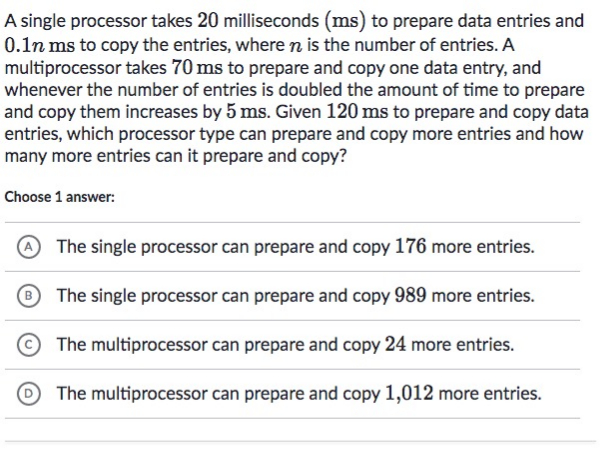AI tutor
Welcome to Bytelearn!
Let’s check out your problem:

A single processor takes milliseconds to prepare data entries and ms to copy the entries, where is the number of entries. A multiprocessor takes ms to prepare and copy one data entry, and whenever the number of entries is doubled the amount of time to prepare and copy them increases by ms. Given ms to prepare and copy data entries, which processor type can prepare and copy more entries and how many more entries can it prepare and copy? Choose answer: (A) The single processor can prepare and copy more entries. (B) The single processor can prepare and copy more entries. (C) The multiprocessor can prepare and copy more entries. (D) The multiprocessor can prepare and copy more entries.
Full solution
Q. A single processor takes milliseconds to prepare data entries and ms to copy the entries, where is the number of entries. A multiprocessor takes ms to prepare and copy one data entry, and whenever the number of entries is doubled the amount of time to prepare and copy them increases by ms. Given ms to prepare and copy data entries, which processor type can prepare and copy more entries and how many more entries can it prepare and copy? Choose answer: (A) The single processor can prepare and copy more entries. (B) The single processor can prepare and copy more entries. (C) The multiprocessor can prepare and copy more entries. (D) The multiprocessor can prepare and copy more entries.
- Calculate time per entry: Calculate the time for the single processor to prepare and copy one entry. Preparation time: Copy time: Total time per entry:
- Calculate entries for single processor: Calculate the number of entries the single processor can handle in . entries
- Calculate time for multiprocessor: Calculate the time for the multiprocessor to prepare and copy one entry. Preparation and copy time:
- Calculate entries for multiprocessor: Calculate the number of entries the multiprocessor can handle in . entries
- Compare entries handled: Compare the number of entries each processor can handle. Single processor: entries Multiprocessor: entries Difference: entries
- Check answer choices: Check the provided answer choices for the closest match. None of the provided choices match the calculated difference.
More problems from Find a value using two-variable equations: word problems
QuestionGet tutor help
QuestionGet tutor help
QuestionGet tutor help
QuestionGet tutor help
QuestionGet tutor help
QuestionGet tutor help
QuestionGet tutor help
QuestionGet tutor help
QuestionGet tutor help
QuestionGet tutor help
